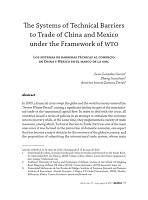The Systems of Technical Barriers to Trade of China and Mexico under the Framework of WTO
DOI:
https://doi.org/10.32870/mycp.v6i17.529Keywords:
TBT, Mexico, China, WTO, Trade, Economy.Abstract
In 2009, a financial crisis swept the globe and the world economy entered the “Severe Winter Period” causing a significant decline in spite of the international trade or the transitional capital flow. In order to deal with the crisis, all countries issued a series of policies in an attempt to stimulate the economy into its recovery while, at the same time, they implemented a variety of trade measures, among which, Technical Barriers to Trade (TBT) was one of the main ones since it was focused in the protection of domestic economy, one aspect that has become a major obstacle for the recovery of the global economy, and the proposition of submitting the international trade system, whose main contents include a multilateral trading system and the rules of WTO, to a severe test. China and Mexico are both emerging economies affected by other countries’ TBT measures, especially China, who became one of the main victims of the current round of trade protectionism. Taking base on the analysis of the current global tbt status and the regulations of the wto, the research will compare similarities and differences of tbt systems between China and Mexico, making recommendations to both nations in order for them to cope with the trade protectionism impact currently prevailing in the world.Downloads
References
Dai, S. (1995). Mexico Federal Law of Standardization and Metrology. Shanghai Standardization, No. 2.
Du, H. (2013). The Challenge and Countermeasures of Trade Protectionism to wto [贸易保护主义对 wto 的挑战及其应对]. Retrieved from http://www.dylw.net/kuaijishenji/119887.html
Fan, J. (2005). Tbt Agreement and the Perfection of Chinese Standardization Law. Public Standardization, No. 11, pp. 11-14.
Li, H. (2005). Thoughts of Standardization Works. Enterprise Standardization, No. 12, pp. 28-30.
Linn, T. (2000). Antidumping in Mexico. Sweden: Lund University.
Ma, L. & Ren, L. (2005). On Perfection of Chinese Standardization Law. Public Standardization, No. 12, pp. 21-24.
Molina, V. I., García, F., Sepúlveda, D., Ávila, R., Jiménez, E., & Martínez, M. (2007). Outlook for the Development of Standards of Implementation of the emc in Mexico. National Meeting of Electrical Metrology.
Ni, Y. (2013). New Tendency of Trade Protection since Financial Crisis. Institute of Chinese World Economics and Politics.
Rodríguez, I. (2014). Interpretación de normas internacionales de distintos ordenamientos bajo el acuerdo de obstáculos técnicos al comercio de la omc. Boletín Mexicano de Derecho Comparado, No. 1, pp. 617-648. Retrieved from https://revistas.juridicas.unam.mx/index.php/derecho-comparado/article/view/4883/6234
World Trade Organization. (2008). Trade Policy Review. Report by Secretariat. Mexico: wt/tpr/s/195. Retrieved from http://www.jmcti.org/kaigai/Latin/2008/2008_03/2008_03_M01.pdf
World Trade Organization. (2013). Concluding remarks by Chairperson. Trade Policy Review
Mexico. Retrieved from http://www.wto.org/english/tratop_e/tpr_e/tp379_crc_e.htm
Yang, J. (2009). Comparative Research on Chinese Standardization Law and Russian Federal Technical Supervision Law. Study on Technical Management, No. 3, pp. 225-228.

Published
How to Cite
Issue
Section
License
Open Access Policy
This journal provides open access to all its contents, in adherence to the principle that making research freely available supports a greater global exchange of knowledge.
MyCP is licensed under a Creative Commons Attribution-NonCommercial license, also known as CC BY-NC.
Contents are published in both PDF and XML formats.
Authors who publish in México y la Cuenca del Pacífico must accept the following conditions:
Pursuant to Mexican copyright laws, México y la Cuenca del Pacífico acknowledges and respects the authors’ moral right and ownership of property rights, which will be assigned to the University of Guadalajara to publish the articles in an open-access mode.
México y la Cuenca del Pacífico does not charge the authors any fees for receiving and processing their articles.
Authors are permitted to enter into other independent and additional contractual agreements for the non-exclusive distribution of the article version published in México y la Cuenca del Pacífico (for example, publishing it in an institutional repository or in other printed or electronic media) as long as they clearly state that the piece was originally published in México y la Cuenca del Pacífico.
Pursuant to the above, once the article is approved for publication, authors must send the Assignment of Rights Agreement form duly filled and signed. This form must be sent to mexicoylacuenca@gmail.com as a PDF file.
Readers/users of México y la Cuenca del Pacífico can freely access the journal new issues as soon as they are uploaded. Readers/users are allowed to cite, share (both electronically and physically), print and distribute the material, provided they expressly state that the work was originally published in México y la Cuenca del Pacífico. Contents are to be properly cited and never for commercial purposes.




